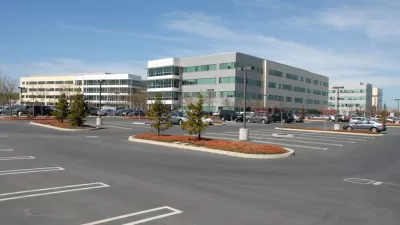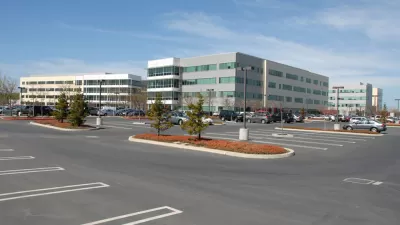The office park has become a suburban given, disliked by some, but once it represented a utopian vision of work away from the city. Here's a look at how the Silicon Valley model developed, and where it might be going.

Benjamin Grant discusses how industry and commerce followed housing's path into suburbanization. "It is not uncommon for tourists to go looking for Silicon Valley only to find themselves lost and disappointed in an ocean of asphalt, and to content themselves with a selfie in front of the Googleplex driveway."
Many of us have fallen out of love with suburbs today, but in the mid 20th-century, office parks promised a working future away from the noise and pollution. "In various ways, research parks replicated the suburban planning and design controls pioneered in the city of Menlo Park in 1948, deliberately presenting an alternative to industrial factories, where most research and development functions had traditionally been housed."
Fairchild Semiconductor, among other firms, pioneered this shift to "clean industry," which initially stoked the concerns of nearby residents enjoying their suburban lifestyle. "To overcome incipient local opposition, suburban enterprises were vigorously marketed as 'smokeless' industries – the very antithesis of polluting urban industries. Zoning was created to facilitate commercial uses while safeguarding suburban character."
Those first forays grew into the modern office park, a profitable and adaptable model. "Large, horizontal floors and open plan spaces could be quickly occupied and reconfigured by fast-moving teams. This building strategy allowed companies to grow quickly in discrete and predictable units and then contract just as quickly by shedding them."
Grant also goes into recent trends, including both a return to the city by several large firms (Airbnb, Yelp, and Salesforce among them), as well as the opposite: giant "prestige campuses" like Apple's upcoming headquarters (budgetary estimates hover at $5 billion). And then there are hybrids from Samsung and Box, bringing urban design principles into suburban surroundings.
FULL STORY: The Corporate Campus: A Local History

Alabama: Trump Terminates Settlements for Black Communities Harmed By Raw Sewage
Trump deemed the landmark civil rights agreement “illegal DEI and environmental justice policy.”

Study: Maui’s Plan to Convert Vacation Rentals to Long-Term Housing Could Cause Nearly $1 Billion Economic Loss
The plan would reduce visitor accommodation by 25% resulting in 1,900 jobs lost.

Why Should We Subsidize Public Transportation?
Many public transit agencies face financial stress due to rising costs, declining fare revenue, and declining subsidies. Transit advocates must provide a strong business case for increasing public transit funding.

Paris Bike Boom Leads to Steep Drop in Air Pollution
The French city’s air quality has improved dramatically in the past 20 years, coinciding with a growth in cycling.

Why Housing Costs More to Build in California Than in Texas
Hard costs like labor and materials combined with ‘soft’ costs such as permitting make building in the San Francisco Bay Area almost three times as costly as in Texas cities.

San Diego County Sees a Rise in Urban Coyotes
San Diego County experiences a rise in urban coyotes, as sightings become prevalent throughout its urban neighbourhoods and surrounding areas.
Urban Design for Planners 1: Software Tools
This six-course series explores essential urban design concepts using open source software and equips planners with the tools they need to participate fully in the urban design process.
Planning for Universal Design
Learn the tools for implementing Universal Design in planning regulations.
Smith Gee Studio
Alamo Area Metropolitan Planning Organization
City of Santa Clarita
Institute for Housing and Urban Development Studies (IHS)
City of Grandview
Harvard GSD Executive Education
Toledo-Lucas County Plan Commissions
Salt Lake City
NYU Wagner Graduate School of Public Service




























